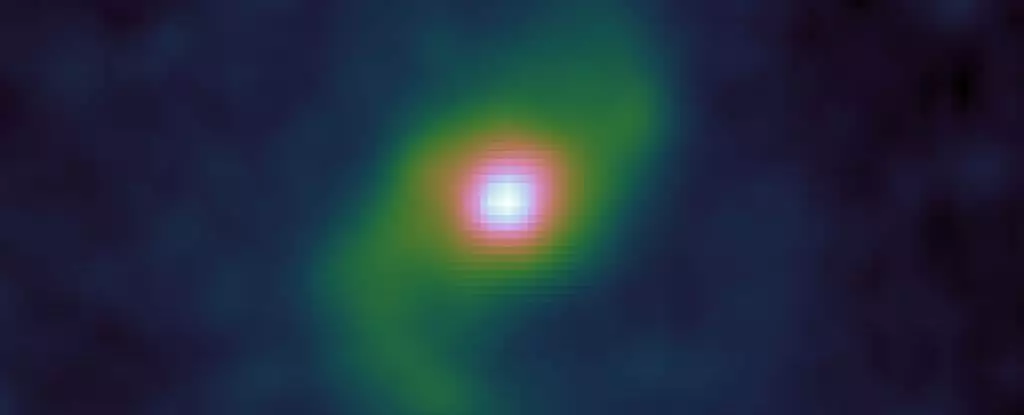The cosmos has always been a source of intrigue, and recent astronomical findings are adding new layers of complexity to our understanding of early galaxy formation. A remarkable revelation has emerged from a study of a colossal spiral galaxy, known as J0107a, detected just 2.6 billion years after the Big Bang. This galaxy has been discovered to sport a strikingly sophisticated structure: a stable galactic bar teeming with stars. Such findings not only challenge previous paradigms about the timeline of galactic evolution but also highlight the rich tapestry of scenarios through which the universe could have unfolded.
Up until now, the prevailing belief has been that galactic structures took their time to develop, beginning with black holes that gradually accrete gas over eons before leading to the formation of stars. However, J0107a throws a wrench into this narrative—indicating that the universe was brewing more complex formations far earlier than astronomers previously hypothesized. Shuo Huang, an astronomer from the National Astronomical Observatory of Japan, articulates this surprise, suggesting that the characteristics of J0107a mirror those of current local galaxies, hinting at a unexpectedly rapid formation process.
Similarities Across Time and Space
One of the most surprising aspects of J0107a is the similarity of its galactic structure to contemporary galaxies. The detailed analysis conducted using advanced observatories such as the James Webb Space Telescope (JWST) and the Atacama Large Millimetre/submillimetre Array (ALMA) has unveiled that this ancient galaxy behaves much like those closer to us today, challenging the notion that the mechanics of galaxy formation were linear and gradual.
The presence of a galactic bar—a feature that serves as crucial conduit for gas flow towards the galactic core—suggests that J0107a has been relatively undisturbed for a significant period. This is intriguing, especially given that bars are thought to be delicate structures susceptible to disruption from galactic interactions. The investigation into how J0107a’s bar is facilitating rapid gas accretion at staggering rates—up to 600 solar masses per year—emphasizes the intricate mechanisms governing early galactic life.
Gas Dynamics and Star Formation Rays
The gas dynamics within J0107a offer a window into the alchemical process of star formation. The rate at which gas is funneled to the galactic core is not just remarkable; it’s almost mind-boggling when one considers the implications of density and mass within the region. The substantial influx of gas—potentially several times faster than in current galaxies including our Milky Way—addresses the question of how such a vigorous rate of star formation materializes so quickly post-Big Bang.
However, this revelation brings with it a torrent of questions about the nature of star formation in the early universe. While the relative density of gas in J0107a might yield high rates of starlight emergence, unresolved queries linger over whether the mechanisms of star formation were consistent with local galaxies. There’s a distinct possibility that the gas dynamics within J0107a could produce stars under conditions that we haven’t yet observed in the present-day universe.
The Cosmic Web: A New Dimension of Inquiry
Huang and his team’s findings further provoke thought about the role of the cosmic web—the vast network of gas that stretches across intergalactic space—in the formation of such a grand structure in the nascent universe. The researchers propose that J0107a’s development may have been significantly influenced by a substantial inflow of gas streaming from this cosmic web, leading to the quick establishment of its galactic disk.
This inquiry opens up exciting avenues for future research. As Huang points out, understanding how cosmic gas aggregates and transforms into a well-structured disk is pivotal. Many theoretical models offer dense frameworks for such behavior, yet direct observations remain elusive. The findings related to J0107a are just the beginning of what may be a revolution in our understanding of cosmic evolution.
Transforming Our Understanding of Galactic Evolution
Ultimately, the discovery of J0107a is a call to reconsider fundamental aspects of our galactic evolution models. The conventional view that galaxies grow primarily through sporadic mergers may require reevaluation, especially in light of evidence indicating a so-called ‘quiet’ evolution for certain early structures. J0107a’s rapid formation raises critical questions about the diverse pathways available during the universe’s formative years.
Moreover, as astronomers gather more data and conduct deeper investigations, we may find that J0107a acts as a benchmark for understanding other spiral galaxies of similar age. The cosmic tapestry is more intricate than we might have dared to imagine, and with each discovery, we unveil a layer of complexity that reshapes our perception of the universe and our place within it. The findings about J0107a are not only captivating but pivotal, igniting the fires of curiosity in the ever-growing field of astrophysics.


Leave a Reply